2022 annual report – Occupational injuries in the Canadian federal jurisdiction
From: Employment and Social Development Canada
On this page
- List of abbreviations
- List of charts
- Territorial acknowledgement
- Executive summary
- Introduction
- Section 1: About the data
- Section 2: Occupational injuries in federal jurisdiction sectors in 2022
- Section 3: Impact of scale of economic activity on work-related injuries
- Section 4: Tracking safety performance trends and exploring regional variations within sectors
- Section 5: Moving forward
- Annex: List of terms
Alternate formats
Large print, braille, MP3 (audio), e-text and DAISY formats are available on demand by ordering online or calling 1 800 O-Canada (1-800-622-6232). If you use a teletypewriter (TTY), call 1-800-926-9105.
List of abbreviations
- AIRT
- Air Transportation
- BANK
- Banking and Banks
- BRID
- Interprovincial Infrastructure (Bridges, Tunnels, Canals, and Causeways)
- BROAD
- Broadcasting (Television, Radio, and Internet)
- COMM
- Communications
- DIFR
- Disabling Injury Frequency Rate
- EAHOR
- Employer’s Annual Hazardous Occurrence Report
- ENER
- Energy, Mining and Mineral Processing
- FEED
- Feed, Flour and Seed
- FIFR
- Fatal Injury Frequency Rate
- FTE
- Full-time Equivalent
- GRAIN
- Grain Handling and Grain Elevators
- INDG
- First Nations, Band Councils, and Indigenous Self-Governments (certain activities)
- LONG
- Longshoring, Stevedoring, Port, Harbour Operations and Pilotage
- PIPE
- Pipeline Transportation
- POST
- Postal Services and Postal Contractors
- PUBS
- Federal Public Services, Public Service Departments and Crown Corporations
- RAIL
- Rail Transportation
- ROAD
- Road Transportation
- WATER
- Water Transportation (Shipping and Ferries)
List of charts
- Chart 2.1: Total number of fatal injuries by federally regulated sector, 2021 vs 2022
- Chart 2.2: Share (%) of total hours worked and total number of disabling injuries by sector in 2022
- Chart 2.3: Disabling Injury Frequency Rates (DIFR) by federally regulated sector in 2022
- Chart 2.4: Fatal Injury Frequency Rates (FIFR) by federally regulated sector in 2022
- Chart 3.1: Change in number of disabling injuries reported between 2021 and 2022 by sector
- Chart 3.2: Changes (%) in hours worked and number of disabling injuries reported between 2021 and 2022 by sector
- Chart 3.3 (a): Change in hours worked from 2019 to 2022 (%)
- Chart 3.3 (b): Change in disabling injuries from 2019 to 2022 (%)
- Chart 4.1 (a): Road Transportation DIFR values, 2018 to 2022
- Chart 4.1 (b): Postal Services and Postal Contractors DIFR values, 2018 to 2022
- Chart 4.1 (c): Air Transportation DIFR values, 2018 to 2022
- Chart 4.1 (d): Federal Public Services DIFR values, 2018 to 2022
- Chart 4.2 (a): Road Transportation DIFR by province and territory in 2022
- Chart 4.2 (b): Postal Services and Postal Contractors DIFR by province and territory in 2022
- Chart 4.2 (c): Air Transportation DIFR by province and territory in 2022
- Chart 4.2 (d): Longshoring, Stevedoring, Port, Harbour Operations and Pilotage DIFR by province and territory in 2022
- Chart 4.2 (e): Feed, Flour and Seed DIFR by province and territory in 2022
Territorial acknowledgement
The 2022 annual report – Occupational injuries in the Canadian federal jurisdiction was produced by the Labour Program, of Employment and Social Development Canada, on the traditional unceded territory of the Algonquin, Anishinabewaki, and Mohawk Peoples. We are grateful for the opportunity to work and be present on this territory.
Executive summary
The Labour Program of Employment and Social Development Canada (ESDC) publishes an annual report to provide aggregated statistics on work-related disabling and fatal injuries within the federal jurisdiction and its regulated industrial sectors. The primary data source for this report is the Employer’s Annual Hazardous Occurrence Report (EAHOR), which federally regulated employers are required to submit to the Labour Program for each reporting year.
This report provides an overview of the state of workplace safety across federally regulated sectors, identifying current challenges and achievements in the field.
Key findings from the 2022 annual report:
- A noticeable increase in work-related injuries was recorded in 2022, with 18,131 disabling injuries reported, marking an increase of 10.9% from 2021 (16,342).
- The number of work-related fatal injuries rose significantly, from 44 in 2021 to 67 in 2022, representing a 52% increase.
- Compared to 2019 (the last reporting year before the COVID-19 global pandemic), the total number of disabling injuries in 2022 was 13% lower, declining from 20,850 in 2019 to 18,131 in 2022.
- Economic activities within the federal jurisdiction have shown signs of post-pandemic recovery, surpassing pre-pandemic levels with a 7.4% increase in total hours worked compared to 2019.
- The extent of this recovery varies significantly among federally regulated sectors. Nine out of 16 sectors have recovered to or surpassed their pre-pandemic total hours worked. For example, the Banking, Energy, Communications and Road Transportation sectors.
- However, total hours worked in other sectors such as Water, Rail and Air Transportation have not yet recovered to pre-pandemic levels.
- The Disabling Injury Frequency Rate (DIFR: The number of reported disabling and fatal injuries per 1 million reported hours worked) for the federal jurisdiction increased by 7.2%, from 7.10 in 2021 to 7.61 in 2022. The 2022 rate is also slightly higher than the 2019 rate (7.39). The 2022 DIFR values for 5 sectors were greater than the federal jurisdiction rate of 7.61:
- Road Transportation (19.89)
- Postal Services and Postal Contractors (18.60)
- Air Transportation (17.38)
- Longshoring, Stevedoring, Port, Harbour Operations and Pilotage (14.93)
- Feed, Flour and Seed (9.39)
- Notable DIFR variations were observed across different sectors and across the different regions of Canada, highlighting the diverse nature of workplace safety challenges across Canada.
- Nine sectors displayed considerable improvement over the past 5 years, while 3 sectors showed a stabilizing trend. For example, the Postal Services and Federal Public Services sectors exhibited positive trends. In contrast, 4 sectors, including Longshoring and Pipeline Transportation, reported worsening performance compared to pre-pandemic.
Introduction
Each year, the Labour Program of Employment and Social Development Canada (ESDC) publishes an annual report on work-related injuries in the federal jurisdiction, aiming to provide an update on the overall safety performance of workplaces across the federal jurisdiction.
The report relies on the data collected in the Employer’s Annual Hazardous Occurrence Report (EAHOR), submitted by federally regulated employers to the Labour Program for each reporting year.
The 2022 annual edition comprises 5 sections:
Section 1- About the data - outlines the data source and the employers and employees represented in this report.
Section 2 - Occupational injuries in federal jurisdiction sectors in 2022 - presents the prevalence of work-related injuries in the federal jurisdiction and the sectors under its jurisdiction for 2022, comparing it with 2021 and with 2019, the year before the outbreak of the COVID-19 global pandemic.
Section 3 - Impact of scale of economic activity on work-related injuries - explores the relationship between changes in economic activity volume (measured in hours worked) and occurrences of injuries in federally regulated workplaces.
Section 4 - Tracking safety performance trends and exploring regional variations within sectors - provides the findings on the safety performance of federally regulated sectors over the past 5 years (2018 to 2022) and regional variations within sectors, based on the Disabling Injury Frequency Rate (DIFR). This standardized safety metric measures the number of disabling and fatal injuries for every 1 million hours worked, facilitating meaningful comparisons across different time periods or between organizations with similar work environments. It offers insights into relative safety performance, enabling the identification of trends and improvements in occupational safety.
Section 5 - Moving forward - concludes the report, offering recommendations for potential steps to strengthen occupational safety performance monitoring and reporting for the federal jurisdiction.
Additionally, the report includes a list of abbreviations and a glossary of terms explaining the definitions of injury rates and other relevant terms used in the publication.
Section 1: About the data
The data presented in this publication originates from the Employer’s Annual Hazardous Occurrence Report, submitted by federally regulated employers to the Labour Program for the 2022 reporting year. The 2022 EAHOR data was extracted on January 22, 2024. Data from previous years were used when analyzing trends or making year-to-year comparisons.
EAHOR submissions
The Occupational Health and Safety (OHS) Regulations under the Canada Labour Code (Code) require that employers subject to federal jurisdiction submit an EAHOR each year by March 1, covering the period from January 1 to December 31 of the preceding calendar year. In an EAHOR, employers are required to provide the following information and data:
- number of disabling injuries
- number of deaths
- number of minor injuries
- number of other hazardous occurrences
- total number of employees (in FTEs)
- number of office employees
- total number of hours worked
- workplace status (active/inactive)
- date status became inactive, if applicable
It is important to note that EAHOR submissions only collect aggregate injury data and do not provide a breakdown of detailed types or severity of injuries. The information contained in this publication is based on what employers have reported to the Labour Program in their EAHOR submissions for calendar year 2022 and therefore may not have captured every injury in the federal jurisdiction.
As illustrated in Table 1.1 below, the 2022 figures presented in this report are collected from a total of 4,459 EAHOR submissions that meet the reporting requirements and have no data errors. These submissions covered approximately 1.2 million Full-time Equivalent (FTE) employees under federal jurisdiction. The total economic activity in 2022, measured by total hours worked, was estimated at around 2,392 million hours.
| Employer size (number of FTEs) | Submissions included in this report | % of total submissions | Total FTEs | % of total FTEs | Total hours worked | % of total hours worked |
|---|---|---|---|---|---|---|
| 1 to 99 | 3,756 | 84.2% | 83,506 | 6.9% | 173,533,473 | 7.3% |
| 100 to 499 | 506 | 11.3% | 108,584 | 9.0% | 217,292,016 | 9.1% |
| 500 and above | 197 | 4.4% | 1,019,041 | 84.1% | 2,001,038,380 | 83.7% |
| Total | 4,459 | 100.0% | 1,211,131 | 100.0% | 2,391,863,869 | 100.0% |
It is notable that 84% (or 3,756) of employers whose EAHOR submissions were included in this report had fewer than 100 FTEs; however, their share of the total FTE population and their corresponding share of total hours worked were only 6.9% and 7.3% respectively.
The remaining 16% (or 703) of employers had 100 or more FTEs, representing 93.1% of the FTE population and accounting for 92.7% of economic activities under federal jurisdiction. The 197 largest employers (with 500 or more FTEs) had the greatest shares of FTEs and total hours worked, both at close to 84%.
The figures presented in Table 1.2 indicate that the smaller the employer, the less likely it is to report disabling injuries.
| Employer size (number of FTEs) | Total EAHOR in this report | EAHOR reported 0 injuries | % of total submissions | EAHOR reported at least 1 injury | % of total submissions | Total disabling injuries reported | % of total disabling injuries |
|---|---|---|---|---|---|---|---|
| 1 to 9 | 1,515 | 1,474 | 97.3% | 41 | 2.7% | 55 | 0.3% |
| 10 to 49 | 1,723 | 1,422 | 82.5% | 301 | 17.5% | 527 | 2.9% |
| 50 to 99 | 518 | 311 | 60.0% | 207 | 40.0% | 648 | 3.6% |
| 100 to 249 | 358 | 166 | 46.4% | 192 | 53.6% | 994 | 5.5% |
| 250 to 499 | 148 | 61 | 41.2% | 87 | 58.8% | 1,110 | 6.1% |
| 500 and above | 197 | 39 | 19.8% | 158 | 80.2% | 14,860 | 81.7% |
| Total | 4,459 | 3,473 | 77.9% | 986 | 22.1% | 18,194 | 100.0% |
Over 97% of employers with 1 to 9 FTEs reported zero disabling or fatal injuries within the workplace compared to close to 20% of employers with 500 or more FTEs. Overall, in 2022, 78% of employers declared no disabling or fatal injuries in their EAHOR submissions.
The reported number of disabling injuries is also positively correlated with the scale of economic activity: the larger the employer size, the higher the number of disabling injuries recorded. 158 employers with 500 or more FTEs reported 14,860 disabling injuries, which accounted for 80% of the total of 18,194 disabling and fatal injuries in 2022. The data also demonstrates significant variations in reported numbers of disabling injuries among employers of similar sizes.
Sectors under federal jurisdiction
According to the Canada Labour Code, federal jurisdiction encompasses any work and/or undertaking or business that is within the legislative authority of the Parliament of Canada. This includes all work deemed to be for the common good of at least 2 provinces and outside the exclusive authority of provincial legislatures. Part II of the Code also applies to employers and employees covered under the Parliamentary Employment and Staff Relations Act.
Section 2: Occupational injuries in federal jurisdiction sectors in 2022
Key occupational injuries statistics
In 2022, a total of 39,465 work-related injuries was reported in nearly 2.4 billion hours worked by federally regulated employees. This includes 18,131 (45.9%) disabling injuries, 67 (0.2%) fatal injuries and 21,267 (53.9%) minor injuries.
Table 2.1 provides statistics for 2022 injuries and economic activity, measured by total hours worked, for each sector under federal jurisdiction.
| Sector | Disabling injuries | Fatal injuries | Minor injuries | Total hours worked | % of total disabling injuries | DIFR |
|---|---|---|---|---|---|---|
| AIRT | 3,020 | 2 | 3,005 | 173,909,934 | 16.7% | 17.38 |
| BANK | 331 | 0 | 995 | 540,005,683 | 1.8% | 0.61 |
| BRID | 1 | 0 | 11 | 541,581 | 0.0% | 1.85 |
| BROAD | 194 | 1 | 276 | 54,118,020 | 1.1% | 3.60 |
| COMM | 946 | 4 | 1,145 | 178,257,679 | 5.2% | 5.33 |
| ENER | 43 | 0 | 124 | 13,518,236 | 0.2% | 3.18 |
| FEED | 159 | 1 | 396 | 17,044,263 | 0.9% | 9.39 |
| GRAIN | 77 | 1 | 188 | 13,539,962 | 0.4% | 5.76 |
| INDG | 91 | 1 | 575 | 34,544,445 | 0.5% | 2.66 |
| LONG | 459 | 1 | 1,009 | 30,812,480 | 2.5% | 14.93 |
| PIPE | 10 | 1 | 18 | 11,261,173 | 0.1% | 0.98 |
| POST | 1,725 | 3 | 942 | 92,923,042 | 9.5% | 18.60 |
| PUBS | 3,840 | 3 | 5,901 | 805,053,160 | 21.2% | 4.77 |
| RAIL | 330 | 2 | 161 | 61,717,609 | 1.8% | 5.38 |
| ROAD | 6,726 | 44 | 5,859 | 340,378,722 | 37.1% | 19.89 |
| WATER | 179 | 3 | 662 | 24,237,880 | 1.0% | 7.51 |
| Canada | 18,131 | 67 | 21,267 | 2,391,863,869 | 100.0% | 7.61 |
As shown in Table 2.1, the top 5 sectors in terms of their shares of total disabling injuries reported in 2022 were:
- Road Transportation (6,726, 37.1%)
- Federal Public Services, Public Service Departments and Crown Corporations (3,840, 21.2%)
- Air Transportation (3,020, 16.7%)
- Postal Services and Postal Contractors (1,725, 9.5%)
- Communications (946, 5.2%)
Altogether, the number of disabling injuries reported in these 5 sectors accounted for 16,257 or 89.7% of the total number of disabling injuries in the federal jurisdiction in 2022.
The data also reveals that in 2022, of the 67 workers in the federal jurisdiction who tragically lost their lives due to fatal injuries at work, 44 fatal injuries (or 65.7%) occurred in the Road Transportation sector. This is followed by the Communications sector, which reported 4 fatal injuries.
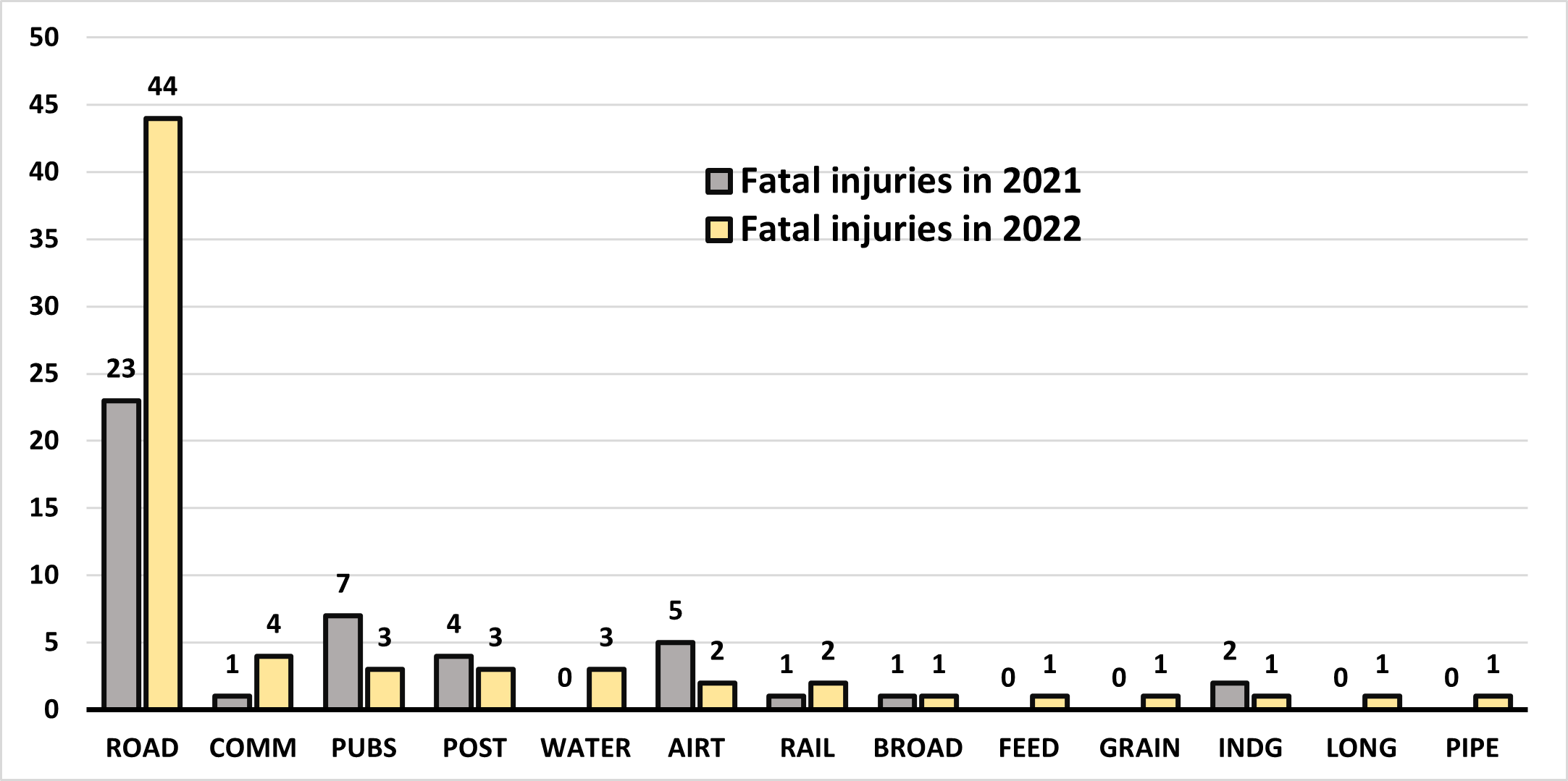
Chart 2.1 – Text description
| Sector | Fatal injuries in 2021 | Fatal injuries in 2022 |
|---|---|---|
| ROAD | 23 | 44 |
| COMM | 1 | 4 |
| PUBS | 7 | 3 |
| POST | 4 | 3 |
| WATER | 0 | 3 |
| AIRT | 5 | 2 |
| RAIL | 1 | 2 |
| BROAD | 1 | 1 |
| FEED | 0 | 1 |
| GRAIN | 0 | 1 |
| INDG | 2 | 1 |
| LONG | 0 | 1 |
| PIPE | 0 | 1 |
Compared to 2021, both work-related disabling and fatal injuries increased in 2022. The number of disabling injuries increased from 16,342 in 2021 to 18,131 in 2022, a rise of 10.9% or 1,789 disabling injuries. Moreover, the number of fatal injuries increased from 44 in 2021 to 67 in 2022, a rise of 23 deaths or 52.3%.
The increase in fatal injuries in federally regulated sectors between 2021 and 2022 is concerning. The analysis of individual sectors reveals varying trends, highlighting the importance of sector-specific safety assessments and targeted interventions to improve workplace safety and prevent future fatal injuries.
Meanwhile, economic activity in the federal jurisdiction, measured by total hours worked, increased by 3.7% or 84.8 million hours worked between 2021 and 2022.
2022 also marks the third year since the outbreak of the COVID-19 global pandemic. Compared to 2019, the data suggests that, in 2022, the overall economic activity in the federal jurisdiction surpassed the 2019 level by 7.4% or by 165.3 million hours worked (2019: 2,227 million vs. 2022: 2,392 million). Conversely, the total number of disabling injuries in 2022 was 13% lower than in 2019, declining from 20,850 in 2019 to 18,131 in 2022. The total number of fatal injuries increased by 1.5%, from 66 in 2019 to 67 in 2022.
Section 3 explores where the reported number of injuries increased or decreased, and to what extent changes in work-related injuries could be attributed to fluctuations in economic activity.
Assessing workplace safety performance for federally regulated sectors
Chart 2.2 illustrates the 2022 shares of total hours worked and total disabling injuries in each sector under federal jurisdiction as a percentage.
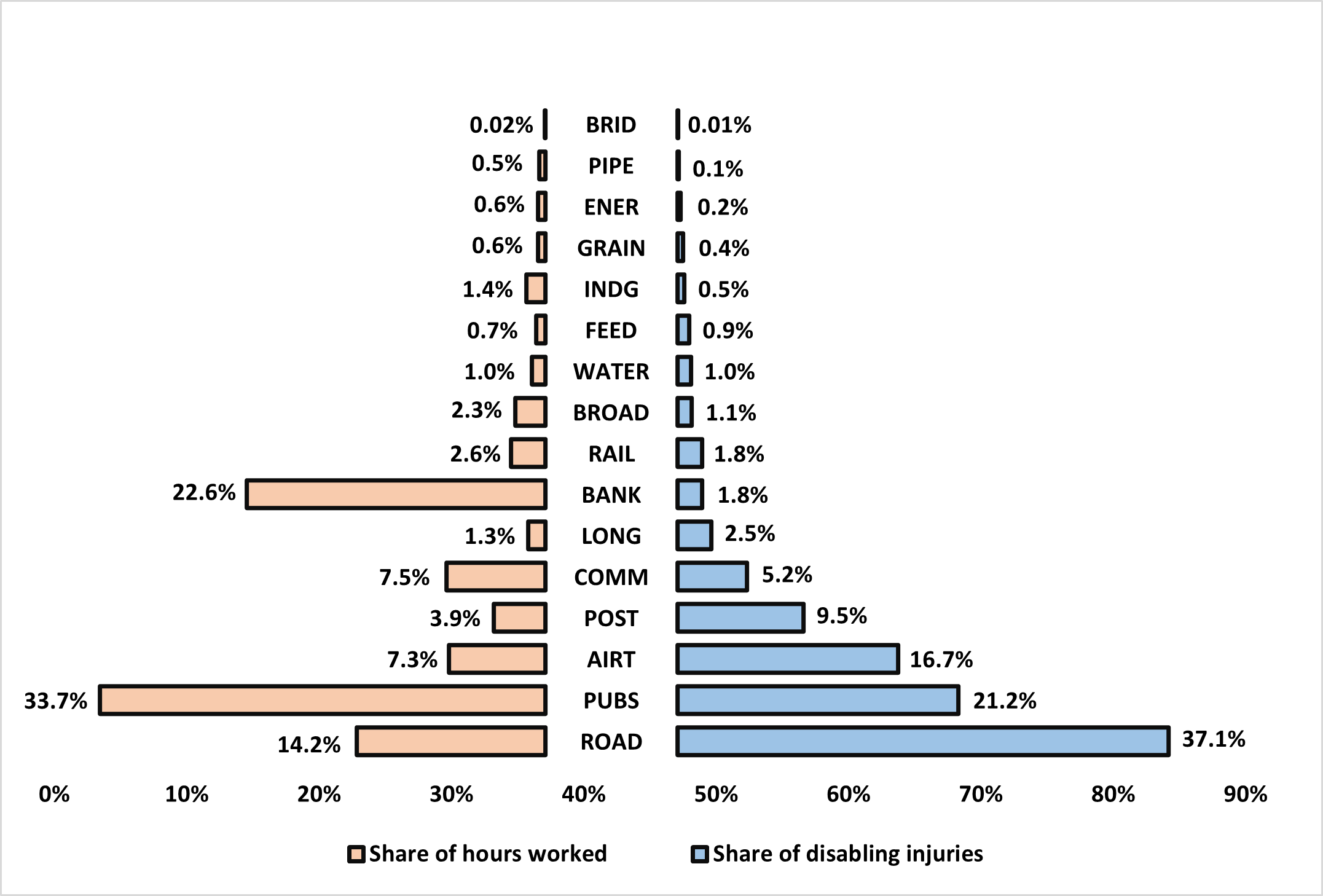
Chart 2.2 – Text description
| Sector | Share of hours worked | Share of disabling injuries |
|---|---|---|
| BRID | 0.02% | 0.01% |
| PIPE | 0.5% | 0.1% |
| ENER | 0.6% | 0.2% |
| GRAIN | 0.6% | 0.4% |
| INDG | 1.4% | 0.5% |
| FEED | 0.7% | 0.9% |
| WATER | 1.0% | 1.0% |
| BROAD | 2.3% | 1.1% |
| RAIL | 2.6% | 1.8% |
| BANK | 22.6% | 1.8% |
| LONG | 1.3% | 2.5% |
| COMM | 7.5% | 5.2% |
| POST | 3.9% | 9.5% |
| AIRT | 7.3% | 16.7% |
| PUBS | 33.7% | 21.2% |
| ROAD | 14.2% | 37.1% |
One method for identifying sectors within the federal jurisdiction with a higher risk or higher prevalence of workplace injuries is by comparing their share of total disabling injuries to their share of total economic activity, measured by total hours worked.
Sectors with a disproportionately high share of disabling injuries relative to their share of total hours worked are deemed to have a higher risk or higher prevalence of workplace injuries. Such sectors may require targeted interventions to ensure workplace safety.
One example of this is the Road Transportation sector. In 2022, its share of total disabling injuries reported in the federal jurisdiction was 37.1%, whereas its share of total hours worked was only 14.2%. This indicates that its share of workplace injuries was approximately 2.6 times greater than its share of economic activities. Conversely, the Banking sector’s share of disabling injuries is much smaller than its share of total hours worked (1.8% versus 22.6%), suggesting that Banking has a notably low prevalence of workplace injuries or is a much safer workplace environment.
Using the ratio between the share of total disabling injuries and the share of total hours worked, we can identify the following 5 sectors as having the highest risk or prevalence of workplace injuries among federally regulated sectors.
| Sector | Share of disabling injuries | Share of total hours worked | Ratio |
|---|---|---|---|
| ROAD | 37.1% | 14.2% | 2.6 |
| POST | 9.5% | 3.9% | 2.4 |
| AIRT | 16.7% | 7.3% | 2.3 |
| LONG | 2.5% | 1.3% | 2.0 |
| FEED | 0.9% | 0.7% | 1.2 |
Disabling Injury Frequency Rate
In the realm of workplace safety and health, the Disabling Injury Frequency Rate (DIFR) serves as a standard safety metric, normalising the number of disabling and fatal injuries for every 1 million hours worked. It is commonly used to compare risks or safety performance across various organizations within similar work environments.

Chart 2.3 – Text description
| Sector | Disabling Injury Frequency Rate (DIFR) |
|---|---|
| ROAD | 19.89 |
| POST | 18.60 |
| AIRT | 17.38 |
| LONG | 14.93 |
| FEED | 9.39 |
| WATER | 7.51 |
| GRAIN | 5.76 |
| RAIL | 5.38 |
| COMM | 5.33 |
| PUBS | 4.77 |
| BROAD | 3.60 |
| ENER | 3.18 |
| INDG | 2.66 |
| BRID | 1.85 |
| PIPE | 0.98 |
| BANK | 0.61 |
| National DIFR | 7.61 |
As illustrated in Chart 2.3, the following 5 sectors exhibited the highest DIFR values, which surpassed that of the federal jurisdiction (7.61). This suggests that these 5 sectors faced the highest safety risks among the sectors within the federal jurisdiction:
- Road Transportation (19.89)
- Postal Services and Postal Contractors (18.60)
- Air Transportation (17.38)
- Longshoring, Stevedoring, Port, Harbour Operations and Pilotage (14.93)
- Feed, Flour and Seed (9.39)
Fatal Injury Frequency Rate
The Fatal Injury Frequency Rate (FIFR), another standard safety metric, is calculated by normalising the number of fatal injuries for every 1 billion hours worked. As with DIFR, it is used to compare risks or safety performance across various organizations within similar work environments.

Chart 2.4 – Text description
| Sector | Fatal Injury Frequency Rate (FIFR) |
|---|---|
| ROAD | 129.27 |
| WATER | 123.77 |
| PIPE | 88.80 |
| GRAIN | 73.86 |
| FEED | 58.67 |
| LONG | 32.45 |
| RAIL | 32.41 |
| POST | 32.28 |
| INDG | 28.95 |
| COMM | 22.44 |
| BROAD | 18.48 |
| AIRT | 11.50 |
| PUBS | 3.73 |
| National FIFR | 28.01 |
Chart 2.4 shows that 9 sectors reported a higher FIFR value than the federal jurisdiction (28.01). This suggests that these 9 sectors faced the highest risk of fatal injuries among the sectors within the federal jurisdiction:
- Road Transportation (129.27)
- Water Transportation (Shipping and Ferries) (123.77)
- Pipeline Transportation (88.80)
- Grain Handling and Grain Elevators (73.86)
- Feed, Flour and Seed (58.67)
- Longshoring, Stevedoring, Port, Harbour Operations and Pilotage (32.45)
- Rail Transportation (32.41)
- Postal Services and Postal Contractors (32.28)
- First Nations, Band Councils, and Indigenous Self-Governments (certain activities) (28.95)
Section 3: Impact of scale of economic activity on work-related injuries
Comparison between 2021 and 2022
This section examines potential connections between work-related injuries and total hours worked. One commonly considered possibility is that more hours worked at a workplace or organization may lead to an increase in exposure to safety risks, which in turn may cause an increase in injuries.
Table 3.1 provides sector-specific statistics on total hours worked (in millions of hours) and the number of disabling injuries for both 2021 and 2022. The table also presents percentage changes in these 2 statistics between the 2 years.
As previously mentioned, the federal jurisdiction saw a significant increase in both disabling and fatal injuries in 2022 compared to the previous reporting year. The data presented in Table 3.1 aims to identify sectors where injury increases occurred and determine whether this was proportional to the change in their work activity level.
| Sector | Total hours worked 2021 (millions) | Total hours worked 2022 (millions) | Number of disabling injuries 2021 | Number of disabling injuries 2022 | Change from 2021 to 2022: hours worked | Change from 2021 to 2022: disabling injuries |
|---|---|---|---|---|---|---|
| PUBS | 750.42 | 805.05 | 2,612 | 3,840 | 7.3% | 47.0% |
| BANK | 522.98 | 540.01 | 557 | 331 | 3.3% | -40.6% |
| ROAD | 345.45 | 340.38 | 6,426 | 6,726 | -1.5% | 4.7% |
| COMM | 191.76 | 178.26 | 1,059 | 946 | -7.0% | -10.7% |
| AIRT | 133.39 | 173.91 | 2,143 | 3,020 | 30.4% | 40.9% |
| POST | 94.43 | 92.92 | 2,003 | 1,725 | -1.6% | -13.9% |
| RAIL | 66.02 | 61.72 | 310 | 330 | -6.5% | 6.5% |
| BROAD | 46.09 | 54.12 | 207 | 194 | 17.4% | -6.3% |
| INDG | 33.83 | 34.54 | 62 | 77 | 2.1% | 24.2% |
| LONG | 32.1 | 30.81 | 377 | 459 | -4.0% | 21.8% |
| WATER | 29.67 | 24.24 | 293 | 179 | -18.3% | -38.9% |
| FEED | 19.79 | 17.04 | 184 | 159 | -13.9% | -13.6% |
| GRAIN | 14.42 | 13.54 | 79 | 91 | -6.1% | 15.2% |
| ENER | 11.93 | 13.52 | 24 | 43 | 13.3% | 79.2% |
| PIPE | 14.26 | 11.26 | 6 | 10 | -21.0% | 66.7% |
| BRID | 0.55 | 0.54 | 0 | 1 | -1.8% | 0 in 2021 |
| Canada | 2,307.08 | 2,391.86 | 16,342 | 18,131 | 3.7% | 11.0% |
Chart 3.1 visually depicts which sectors reported an increase in disabling injuries and which ones reported a decrease between 2021 and 2022.
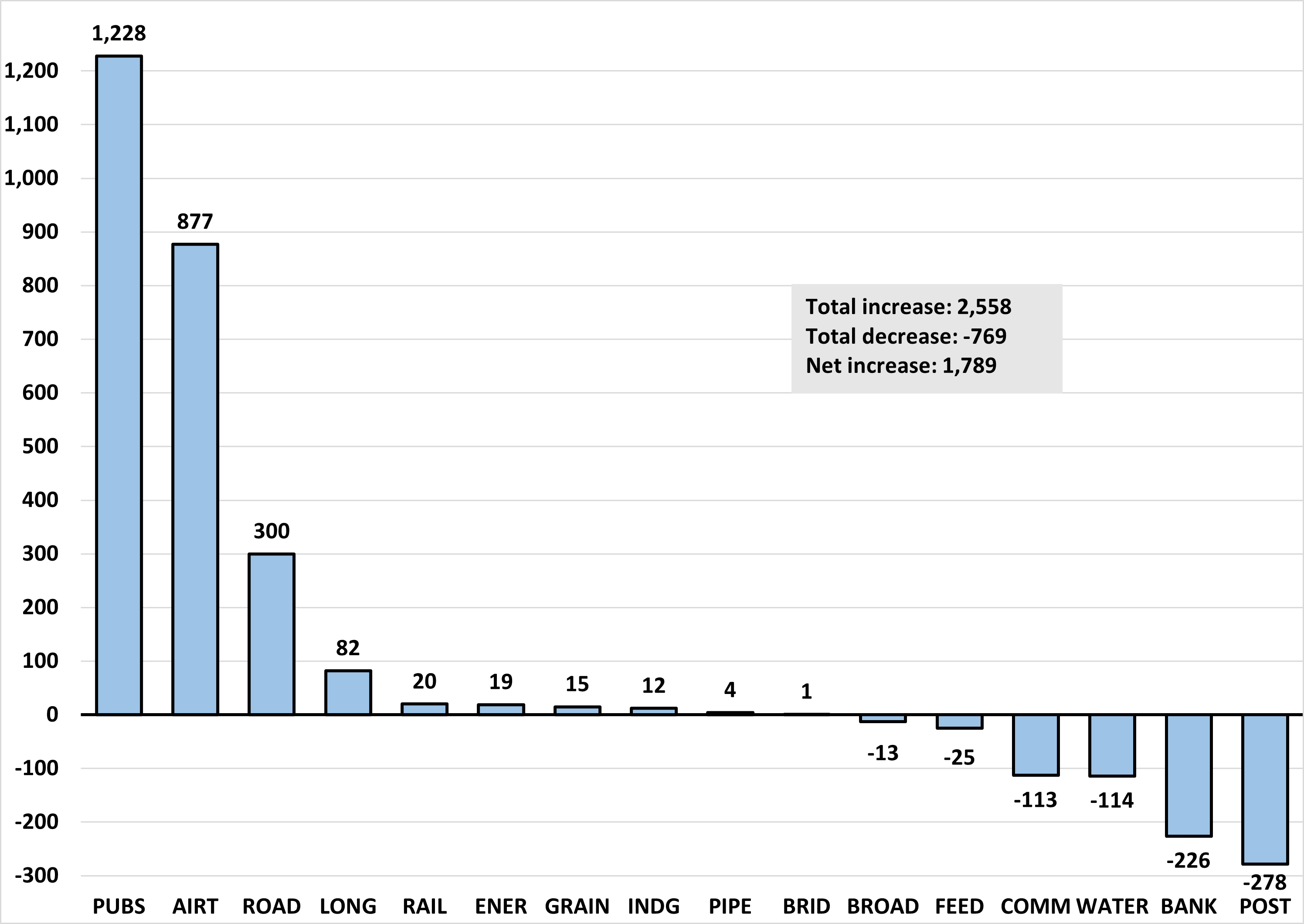
Chart 3.1 – Text description
| Sector | Change from 2021 to 2022 |
|---|---|
| PUBS | 1,228 |
| AIRT | 877 |
| ROAD | 300 |
| LONG | 82 |
| RAIL | 20 |
| ENER | 19 |
| GRAIN | 15 |
| INDG | 12 |
| PIPE | 4 |
| BRID | 1 |
| BROAD | -13 |
| FEED | -25 |
| COMM | -113 |
| WATER | -114 |
| BANK | -226 |
| POST | -278 |
| Total increase | 2,558 |
| Total decrease | -769 |
| Net increase | 1,789 |
As illustrated in Chart 3.1, it is evident that the net increase in disabling injuries (1,789) reported in the federal jurisdiction in 2022 compared to 2021 can be primarily attributed to significant increases in disabling injuries in the Federal Public Services, Air Transportation, Road Transportation and Longshoring sectors. Moreover, the decrease in injuries observed in sectors such as Postal Services, Banking, Water Transportation and Communications, along with marginal increases in some other sectors, partially offset the overall increase of 2,558 disabling injuries. This was 42.9% larger than the net increase.
Chart 3.2 presents the percentage changes in total hours worked and the number of disabling injuries reported between 2021 and 2022 for each sector in the federal jurisdiction. The chart shows that while there may be some correlation between the number of work injuries and the amount of work conducted, the relationship between these statistics appears to be complex.
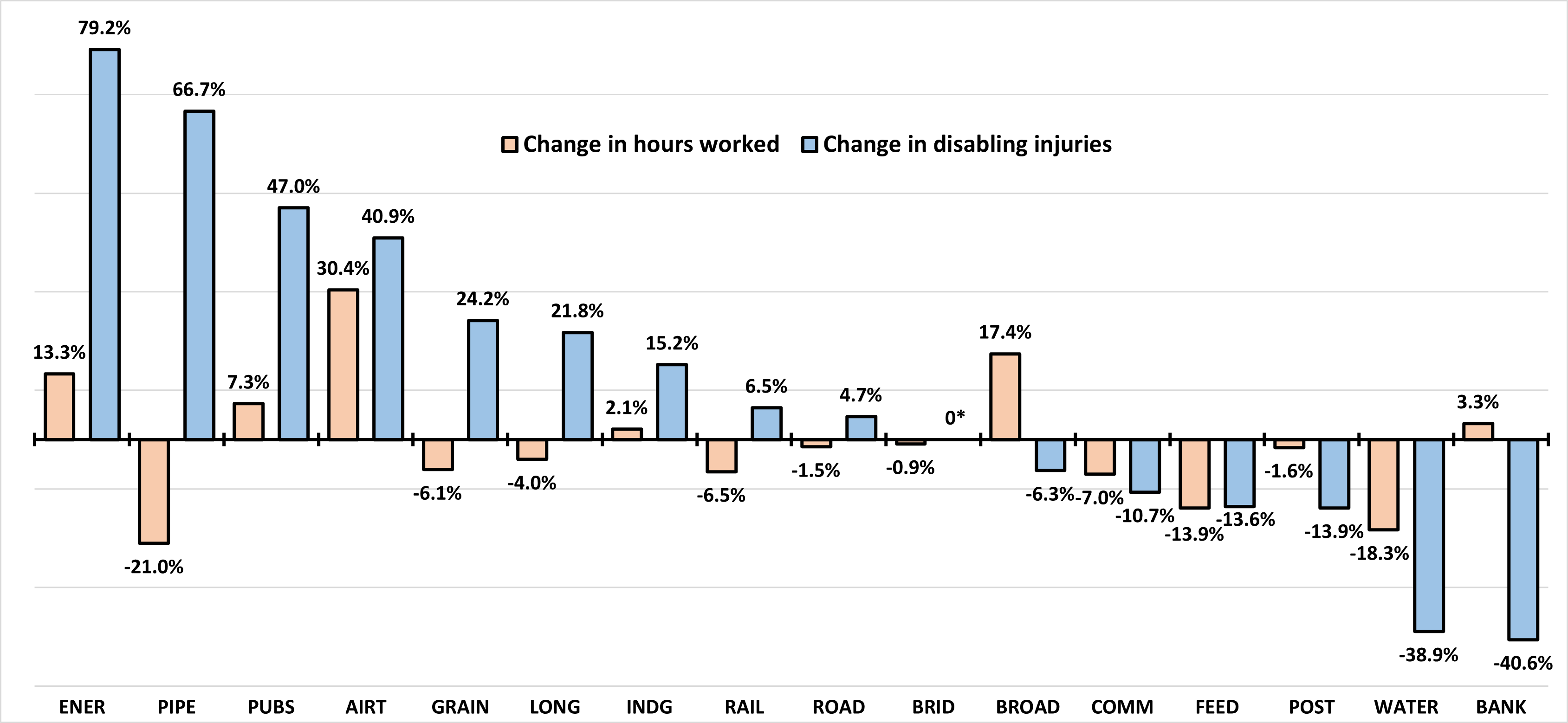
- Footnote *
-
Because no disabling injuries were reported in BRID in 2021, there was no percentage change from 2021 to 2022 in this sector.
Chart 3.2 – Text description
| Sector | Change in hours worked | Change in disabling injuries |
|---|---|---|
| ENER | 13.3% | 79.2% |
| PIPE | -21.0% | 66.7% |
| PUBS | 7.3% | 47.0% |
| AIRT | 30.4% | 40.9% |
| GRAIN | -6.1% | 24.2% |
| LONG | -4.0% | 21.8% |
| INDG | 2.1% | 15.2% |
| RAIL | -6.5% | 6.5% |
| ROAD | -1.5% | 4.7% |
| BRID | -0.9% | 0Footnote * |
| BROAD | 17.4% | -6.3% |
| COMM | -7.0% | -10.7% |
| FEED | -13.9% | -13.6% |
| POST | -1.6% | -13.9% |
| WATER | -18.3% | -38.9% |
| BANK | 3.3% | -40.6% |
The data indicate that certain sectors exhibited strong positive correlations between the changes in these statistics, implying that as total hours worked increase, the number of injuries also tends to increase proportionally and vice versa.
For example, the Feed, Flour and Seed sector experienced proportional reductions in both total hours worked and the number of disabling injuries (change in hours worked: -13.9%, change in the number of disabling injuries: -13.6%). A similar pattern was observed in the Communications sector, where the sector saw a comparable scale of reductions in both hours worked (-7.0%) and the number of disabling injuries (-10.7%).
Conversely, the Air Transportation sector experienced relatively noticeable increases in both total hours worked and the number of disabling injuries (change in hours worked: 30.4%, change in the number of disabling injuries: 40.9%). However, the 10% higher increase in the number of disabling injuries than hours worked may signal a weaker correlation, and potentially indicate a worsening safety performance for the sector.
In other cases, the connections between the 2 statistics also appear weaker or even negligible. For example, the Banking sector saw a slight increase in hours worked (3.3%) yet a significant reduction in injuries (-40.6%). This may signal a considerable improvement in safety performance for the Banking sector.
In contrast, the Federal Public Services sector had a 7.3% increase in total hours worked, but its number of disabling injuries increased disproportionally by 47.0%. This may warrant closer monitoring and further investigation into the reason for the increase in the number of disabling injuries.
In brief, the analysis presented in this part of Section 3 indicates that the relationship between the number of work injuries and the amount of work completed can vary and is not always straightforward. Fluctuations in the economic activity scale cannot be singly attributable to changes in the number of work injuries. While correlations may exist, it is essential to consider multiple factors that can influence this relationship.
These factors include regulatory compliance, workplace safety practices, job complexity, fatigue and stress, technology and automation, and training and skill level. For example, adherence to safety regulations and compliance with occupational health and safety standards can impact the number of work injuries. Organizations that prioritize compliance are likely to have better safety records. Employers with robust safety practices and a culture of prioritizing employee well-being may experience fewer work injuries, regardless of the number of hours worked. Adequate training, proper safety protocols, and the use of protective equipment can contribute to a safer work environment.
Comparison between 2019 and 2022
This part of Section 3 delves into whether the economic scale in the federal jurisdiction has fully rebounded compared to 2019, the year prior to the COVID-19 global pandemic. This section also explores the possible impact of this recovery on workplace safety performance.
Table 3.2 presents the statistics and percentage changes in total hours worked and the number of disabling injuries reported between 2019 and 2022 for each federally regulated sector and the entire federal jurisdiction.
| Sector | Total hours worked 2019 (millions) | Total hours worked 2022 (millions) | Number of disabling injuries 2019 | Number of disabling injuries 2022 | Change between 2019 and 2022: hours worked | Change between 2019 and 2022: disabling injuries |
|---|---|---|---|---|---|---|
| PUBS | 691.39 | 805.05 | 3,725 | 3,840 | 16.4% | 3.1% |
| BANK | 455.46 | 540.01 | 822 | 331 | 18.6% | -59.7% |
| ROAD | 327.65 | 340.38 | 6,908 | 6,726 | 3.9% | -2.6% |
| COMM | 158.90 | 178.26 | 801 | 946 | 12.2% | 18.1% |
| AIRT | 228.67 | 173.91 | 3,511 | 3,020 | -23.9% | -14.0% |
| POST | 92.69 | 92.92 | 2,990 | 1,725 | 0.3% | -42.3% |
| RAIL | 69.67 | 61.72 | 726 | 330 | -11.4% | -54.5% |
| BROAD | 55.71 | 54.12 | 325 | 194 | -2.9% | -40.3% |
| INDG | 37.94 | 34.54 | 90 | 91 | -8.9% | 1.1% |
| LONG | 30.73 | 30.81 | 342 | 459 | 0.3% | 34.2% |
| WATER | 26.71 | 24.24 | 269 | 179 | -9.2% | -33.5% |
| FEED | 18.51 | 17.04 | 223 | 159 | -7.9% | -28.7% |
| GRAIN | 15.00 | 13.54 | 92 | 77 | -9.7% | -16.3% |
| ENER | 5.68 | 13.52 | 14 | 43 | 138.1% | 207.1% |
| PIPE | 11.05 | 11.26 | 8 | 10 | 1.9% | 25.0% |
| BRID | 0.84 | 0.54 | 4 | 1 | -35.5% | -75.0% |
| Canada | 2,226.60 | 2,391.86 | 20,850 | 18,131 | 7.4% | -13.0% |
As depicted in Table 3.2, it is evident that while the federal jurisdiction as a whole appears to have recovered economically to pre-pandemic levels (with a 7.4% increase in total hours worked compared to 2019), the extent of this recovery varies significantly among federally regulated sectors.
The percentage changes in total hours worked between 2019 and 2022 have been used to describe the level of economic recovery for each sector using the following thresholds:
- Surpassed pre-pandemic levels: Above +5% change (Yellow in Chart 3.3 (a))
- Recovered or almost recovered to pre-pandemic levels: Between -5% and +5% change (Orange in Chart 3.3 (a))
- Not quite recovered to pre-pandemic levels: Between -5% and -10% change (Blue in Chart 3.3 (a))
- Not yet recovered to pre-pandemic levels: Below -10% change (Grey in Chart 3.3 (a))
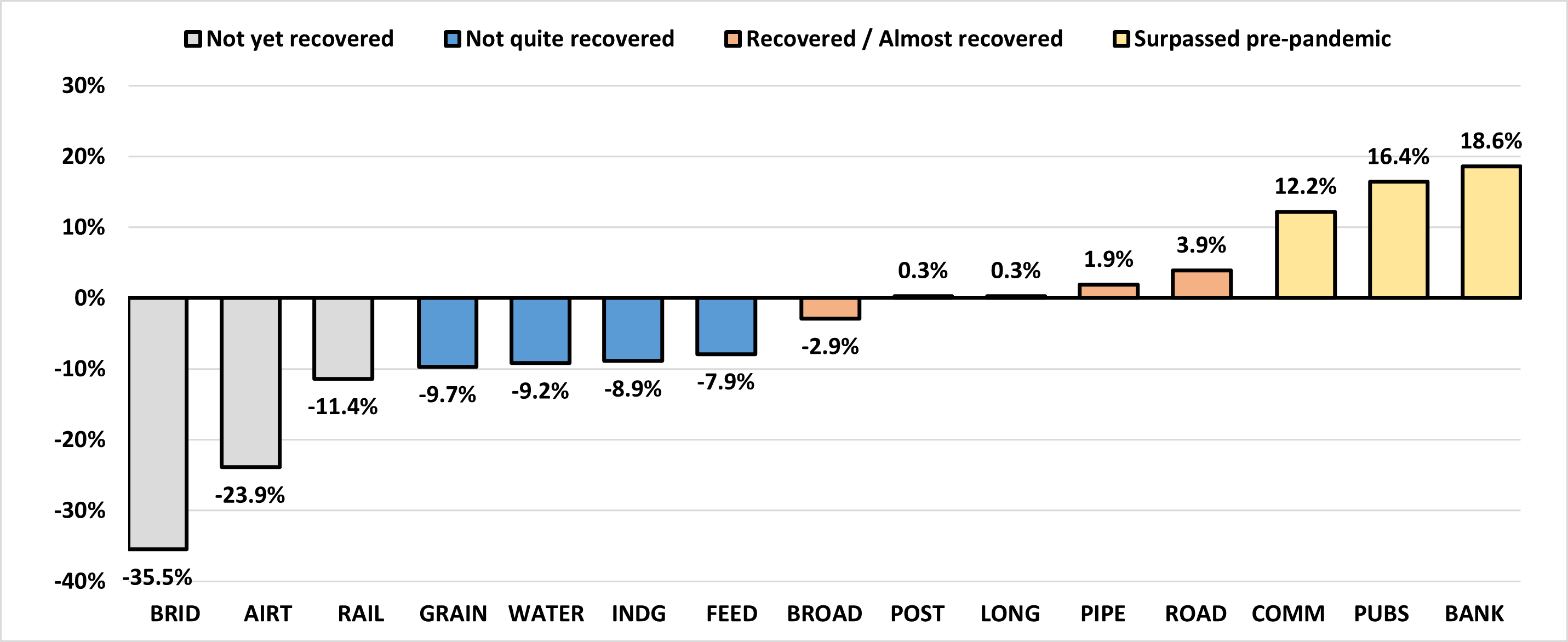
- Footnote *
-
ENER is removed from this chart due to its percentage change being significantly larger than the other sectors (138.1%).
Chart 3.3 (a) – Text description
| Sector | Change in hours worked from 2019 to 2022 |
|---|---|
| BRID | -35.5% |
| AIRT | -23.9% |
| RAIL | -11.4% |
| GRAIN | -9.7% |
| WATER | -9.2% |
| INDG | -8.9% |
| FEED | -7.9% |
| BROAD | -2.9% |
| LONG | 0.3% |
| POST | 0.3% |
| PIPE | 1.9% |
| ROAD | 3.9% |
| COMM | 12.2% |
| PUBS | 16.4% |
| BANK | 18.6% |
For comparing workplace safety performance between 2019 and 2022, a similar scale of change scores for thresholds can be applied, measured by the percentage change in the number of disabling injuries between the 2 years:
- Safety performance below pre-pandemic levels: Above +5% change (Grey in Chart 3.3 (b))
- Safety performance as good as pre-pandemic levels: Between -5% and +5% change (Orange in Chart 3.3 (b))
- Safety performance above pre-pandemic levels: Below -5% change (Green in Chart 3.3 (b))
Based on these criteria and data from Table 3.2, with a change score of minus 13% in disabling injuries, the federal jurisdiction overall experienced a significant improvement in safety performance compared to the pre-pandemic era. However, considerable variations exist among sectors as demonstrated in Chart 3.3 (b).

- Footnote *
-
ENER is removed from this chart due to its percentage change being significantly larger than the other sectors (207.1%).
Chart 3.3 (b) – Text description
| Sector | Change in disabling injuries from 2019 to 2022 |
|---|---|
| BRID | -75.0% |
| BANK | -59.7% |
| RAIL | -54.5% |
| POST | -42.3% |
| BROAD | -40.3% |
| WATER | -33.5% |
| FEED | -28.7% |
| GRAIN | -16.3% |
| AIRT | -14.0% |
| ROAD | -2.6% |
| INDG | 1.1% |
| PUBS | 3.1% |
| COMM | 18.1% |
| PIPE | 25.0% |
| LONG | 34.2% |
The reduction in safety performance for certain sectors could be due to ongoing economic recovery (to pre-pandemic levels), as measured by total hours worked in 2019 compared to 2022. This may be the case for the following sectors:
- First Nations band councils and Indigenous self-governments (certain activities)
- Feed, Flour and Seed
- Water Transportation (Shipping and Ferries)
- Rail Transportation
- Interprovincial Infrastructure (Bridges, Tunnels, Canals, and Causeways)
- Grain Handling and Grain Elevators
On the other hand, businesses could have expanded relative to pre-pandemic levels based on changes in total hours worked from 2019 to 2022. This may have resulted in an impact on safety performance for the following sectors:
- Energy, Mining and Mineral Processing
- Communications
It is essential to exercise caution when interpreting the findings for sectors whose economic activity has not yet fully recovered from the impact of the COVID-19 global pandemic or has surpassed their pre-pandemic level. Their current performance could be temporary due to business contraction or expansion, warranting ongoing monitoring.
Section 4: Tracking safety performance trends and exploring regional variations within sectors
As previously identified, the Disabling Injury Frequency Rate (DIFR) serves as a standardized metric for assessing workplace safety, which enables comparisons across different organizations and time periods. This section utilizes DIFR values to analyze long-term safety trends for federally regulated sectors and explore variations in safety performance across these sectors.
Part 2 of this section delves into the variations in safety performances that may exist within a sector. This information can be potentially helpful in identifying best practices or lessons to be learned, offering relevant insights on how to mitigate workplace safety risks and reduce work-related injuries.
Tracking safety trends for federally regulated sectors from 2018 to 2022
Part 1 of this section demonstrates how DIFR can be employed to track long-term safety trends for federally regulated sectors by analyzing sector-specific DIFR values over the past 5 years between 2018 and 2022.
Safety trend analysis is conducted for the following 4 sectors, which reported 84.4% of all disabling injuries in the federal jurisdiction in 2022: Road Transportation, Postal Services, Air Transportation, and Federal Public Services.
Road Transportation
The Road Transportation sector reported a DIFR of 19.89 in 2022 (an increase of 6.5% from 2021), the highest within the federal jurisdiction. It also reported 6,726 disabling injuries, which was 37.1% of all disabling injuries in the federal jurisdiction and the largest share of any sector. Chart 4.1 (a) displays the variations in DIFR for the Road Transportation sector from 2018 to 2022.

Chart 4.1 (a) – Text description
| Year | Disabling Injury Frequency Rate (DIFR) |
|---|---|
| 2018 | 19.76 |
| 2019 | 21.20 |
| 2020 | 17.88 |
| 2021 | 18.67 |
| 2022 | 19.89 |
As indicated in Chart 4.1 (a), in 2019, there was an increase in the DIFR by 7.3% compared to 2018, while in 2020, there was a notable 15.7% decrease in the injury rate. The subsequent years, 2021 and 2022, show a slight increase in the DIFR compared to the lowest value in 2020. The data demonstrate a fluctuating trend in the DIFR values within the Road Transportation sector during the specified timeframe, possibly reflecting the impact of the COVID-19 global pandemic and subsequent business recovery.
Postal Services and Postal Contractors
The Postal Services sector reported a DIFR of 18.60 in 2022, the second highest DIFR within the federal jurisdiction. However, this sector’s DIFR value decreased from 21.25 in 2021 to 18.60 in 2022, as seen in Chart 4.1 (b).
Chart 4.1 (b) presents the variations in the DIFR over the specified 5-year period observed between 2018 and 2022 for the Postal Services sector.
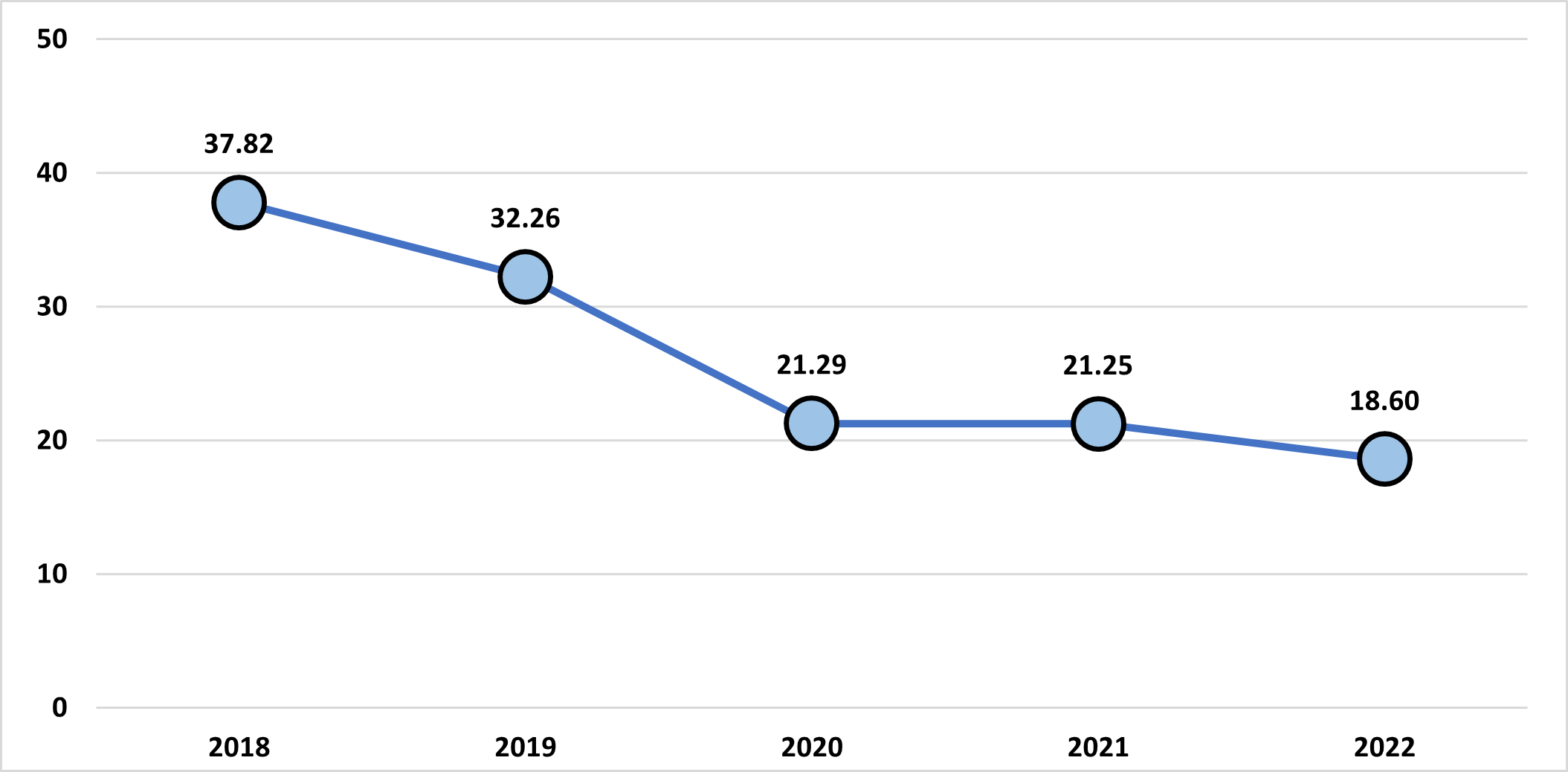
Chart 4.1 (b) – Text description
| Year | Disabling Injury Frequency Rate (DIFR) |
|---|---|
| 2018 | 37.82 |
| 2019 | 32.26 |
| 2020 | 21.29 |
| 2021 | 21.25 |
| 2022 | 18.60 |
The trend depicted in Chart 4.1 (b) indicates a significant decrease in the DIFR from 2018 to 2022, suggesting an improvement in safety within this sector. The decrease from 2018 to 2020, which is about 44%, is particularly notable, indicating a substantial improvement in safety during that period. It may also reflect partially the impact of the COVID-19 global pandemic. The data overall, however, suggests a positive trend in reducing disabling injuries within the Postal Services sector.
Air Transportation
The Air Transportation sector reported a DIFR of 17.38, the third-highest rate in the federal jurisdiction. Chart 4.1 (c) illustrates this sector’s DIFR variations over the past 5 years from 2018 to 2022.

Chart 4.1 (c) – Text description
| Year | Disabling Injury Frequency Rate (DIFR) |
|---|---|
| 2018 | 16.29 |
| 2019 | 15.40 |
| 2020 | 13.34 |
| 2021 | 16.10 |
| 2022 | 17.38 |
The DIFR trend in the chart indicates that there was a notable 18% decrease in the DIFR from 2018 to 2020, possibly influenced by business contraction due to the COVID-19 global pandemic. However, in 2021, there was an increase of 21%, reaching a comparable level to 2018, coinciding with the gradual business post-pandemic recovery. In 2022, the DIFR for the Air Transportation sector continued to rise, surpassing the pre-pandemic rates. The data suggest a moderate fluctuating trend in the safety performance of this sector, but its upward DIFR trend warrants closer monitoring as the sector progresses towards full recovery from the impact of the pandemic.
Federal Public Services
The Federal Public Services sector reported 3,840 disabling injuries, or 21.2% of all disabling injuries in 2022. This is the second-largest share of the total number of disabling injuries in the federal jurisdiction. However, its DIFR suggests a much safer work environment, particularly when comparing this sector to the rest of the top 5 sectors measured by DIFR values.
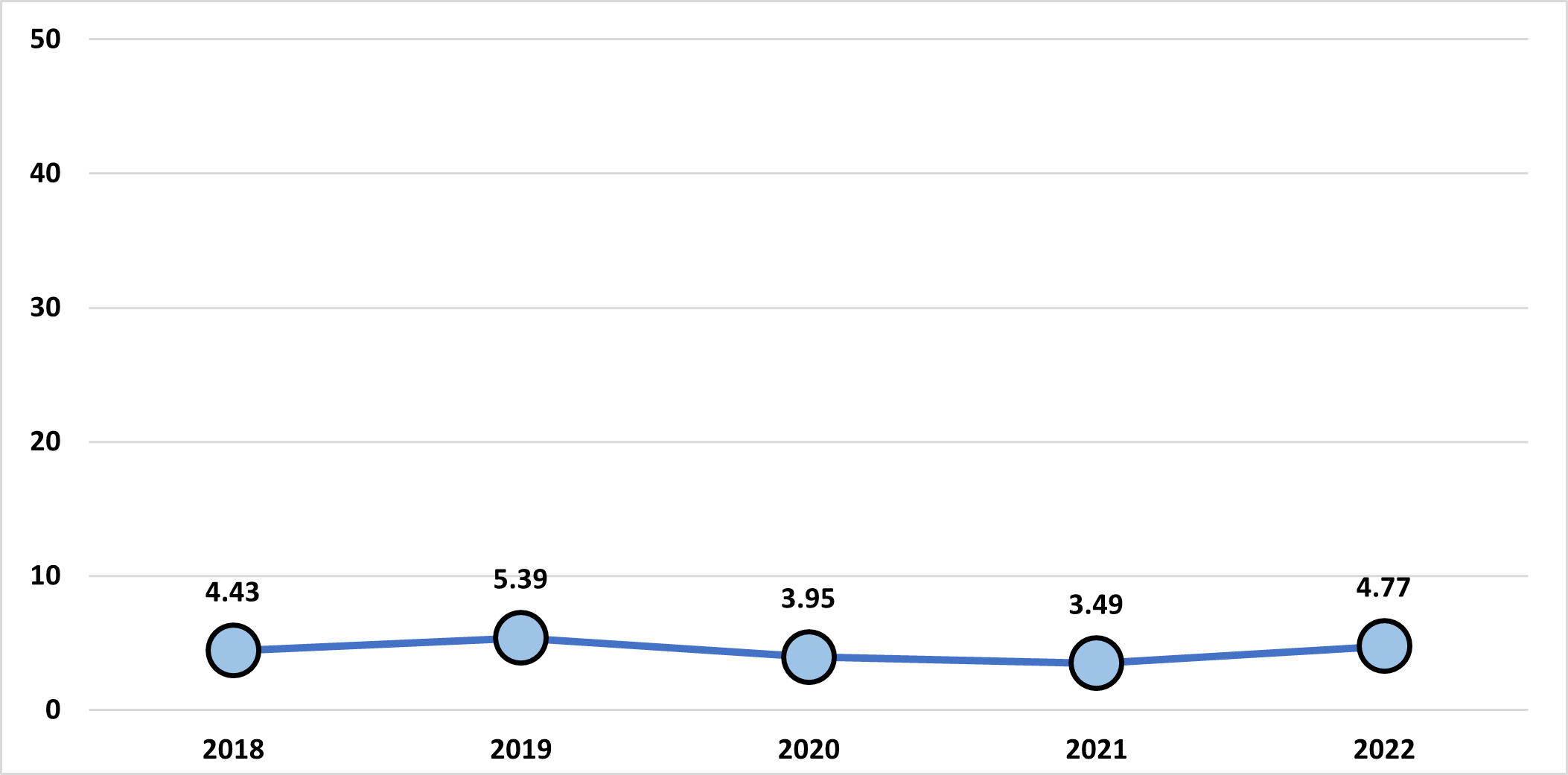
Chart 4.1 (d) – Text description
| Year | Disabling Injury Frequency Rate (DIFR) |
|---|---|
| 2018 | 4.43 |
| 2019 | 5.39 |
| 2020 | 3.95 |
| 2021 | 3.49 |
| 2022 | 4.77 |
The data illustrated in Chart 4.1 (d) indicate that in 2019, there was an increase in the DIFR compared to the previous year, but the sector reported a notable decrease in 2020 and another decrease in 2021. Cumulatively, this amounted to a 35% decline in the DIFR from 2019 to 2021, possibly influenced by the impact of telework arrangements due to the COVID-19 global pandemic.
During the pandemic, rather than experiencing business contraction, the Federal Public Services sector expanded its services to meet the challenges arising from the health crisis. By 2022, the sector reported a 16.4% increase in total hours worked compared to 2019. However, in 2022, there was a notable increase in the DIFR compared to its 2021 value.
Overall, the data suggest a marginal fluctuating trend in the sector’s DIFR between 2018 and 2022, but the fact that the DIFR appears to be gradually returning to its pre-pandemic value may warrant close and ongoing observation.
Exploring variations in regional safety performance within sectors
Employers within federally regulated sectors are located throughout Canada. Like many countries, Canadian provinces and territories may exhibit their own unique as well as shared occupational health and safety risks. These regional characteristics contribute to the diverse array of factors that can lead to workplace injuries. While EAHOR, as previously noted, does not gather data on local characteristics, deriving estimates of regional differences in safety performance can shed light on the underlying causes of hazardous incidents.
Moreover, understanding these regional variations can facilitate the identification of employers with better safety performance. The experiences and strategies employed by these organizations in managing safety risks can serve as best practices, offering valuable lessons to other employers aiming to enhance their safety records.
This part of Section 4 presents regional variations in DIFR values for a select number of sectors, including the Road Transportation, Postal Services and Postal Contractors, Air Transportation, and Feed, Flour and Seed sectors. These 5 sectors reported a DIFR at the national level that was greater than 7.61, the DIFR for the entire federal jurisdiction.
Road Transportation
The Road Transportation sector reported a DIFR of 18.67 at the national level in 2021, which increased to 19.89 in 2022. Five provinces reported a DIFR above the 2022 rate.
| Region | DIFR | Disabling injuries | Hours worked |
|---|---|---|---|
| Newfoundland and Labrador | 25.96 | 50 | 1,925,670 |
| British Columbia | 23.11 | 740 | 32,062,019 |
| Quebec | 22.67 | 1,650 | 72,969,178 |
| Nova Scotia | 20.93 | 147 | 7,168,125 |
| Ontario | 20.04 | 2,654 | 133,203,504 |
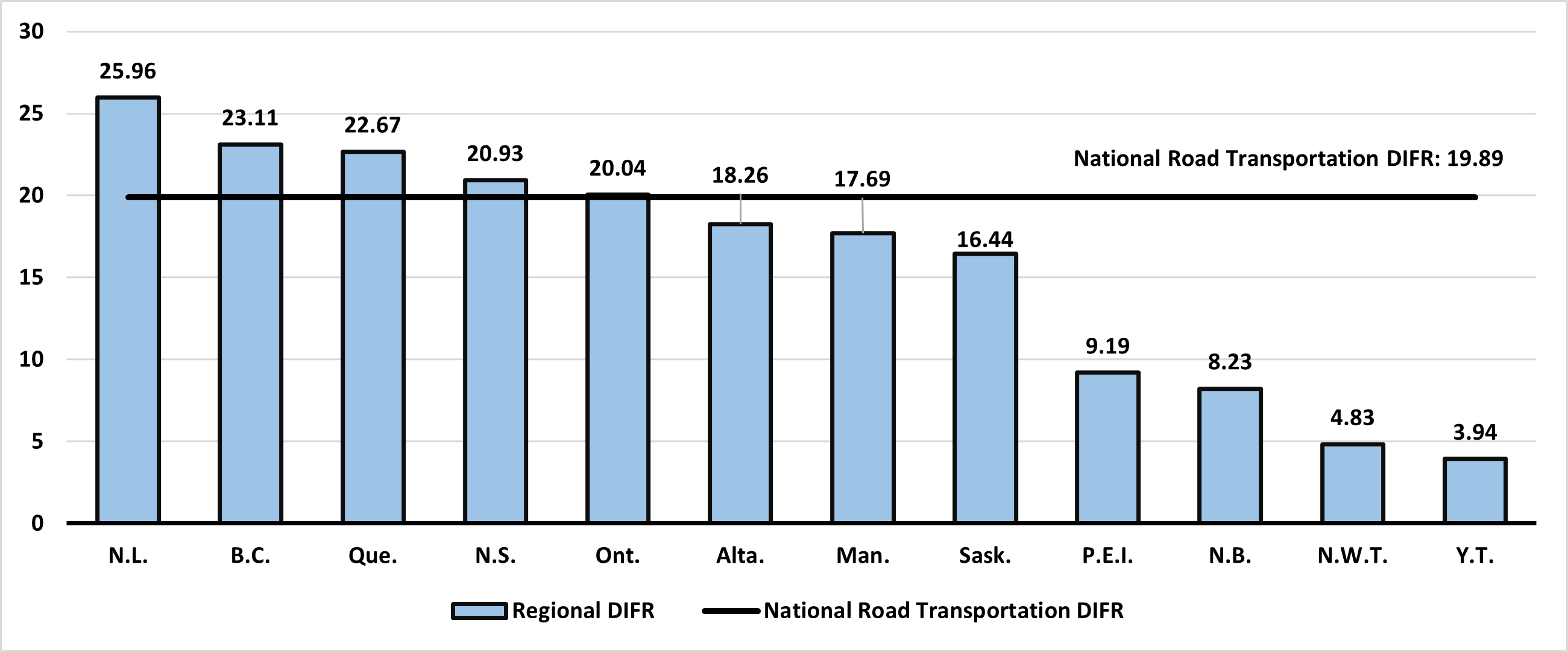
Chart 4.2 (a) – Text description
| Region | Disabling Injury Frequency Rate (DIFR) |
|---|---|
| N.L. | 25.96 |
| B.C. | 23.11 |
| Que. | 22.67 |
| N.S. | 20.93 |
| Ont. | 20.04 |
| Alta. | 18.26 |
| Man. | 17.69 |
| Sask. | 16.44 |
| P.E.I. | 9.19 |
| N.B. | 8.23 |
| N.W.T. | 4.83 |
| Y.T. | 3.94 |
| National Road Transportation DIFR | 19.89 |
As illustrated in Chart 4.2 (a), the Road Transportation sector employers located in different provinces or territories vary greatly in their safety performance measured by the DIFR, ranging from 3.94 (Yukon) to 25.96 (Newfoundland and Labrador).
Postal Services and Postal Contractors
The Postal Services sector reported a DIFR of 21.25 at the national level in 2021, which decreased to 18.60 in 2022. Five regions reported a DIFR above the 2022 rate.
| Region | DIFR | Disabling injuries | Hours worked |
|---|---|---|---|
| Nunavut | 44.83 | 2 | 44,609 |
| New Brunswick | 37.86 | 80 | 2,113,060 |
| British Columbia | 23.19 | 280 | 12,076,235 |
| Saskatchewan | 20.19 | 61 | 3,021,196 |
| Nova Scotia | 19.54 | 52 | 2,764,234 |
| Quebec | 19.32 | 363 | 18,789,224 |

Chart 4.2 (b) – Text description
| Region | Disabling Injury Frequency Rate (DIFR) |
|---|---|
| Nvt. | 44.83 |
| N.B. | 37.86 |
| B.C. | 23.19 |
| Sask. | 20.19 |
| N.S. | 19.54 |
| Que. | 19.32 |
| Ont. | 17.20 |
| Alta. | 16.43 |
| M.B. | 11.91 |
| N.L. | 11.43 |
| P.E.I. | 5.40 |
| National Postal Services and Postal Contractors DIFR | 18.60 |
As depicted in Chart 4.2 (b), employers in the Postal Services sector exhibited significantly wide variations in their safety performance measured by DIFR across different regions. The rates ranged from the lowest rate of 5.40 (P.E.I.) to the highest rate of 44.83 (Nunavut), which is over 2.4 times higher than the sectoral benchmark (18.60).
Air Transportation
The Air Transportation sector reported a DIFR of 16.10 at the national level in 2021, which increased to 17.38 in 2022. Two provinces and 1 territory reported a DIFR above the sector’s national 2022 rate.
| Region | DIFR | Disabling injuries | Hours worked |
|---|---|---|---|
| Nunavut | 31.99 | 39 | 1,219,189 |
| British Columbia | 22.78 | 561 | 24,629,144 |
| Ontario | 21.57 | 1,234 | 57,263,029 |
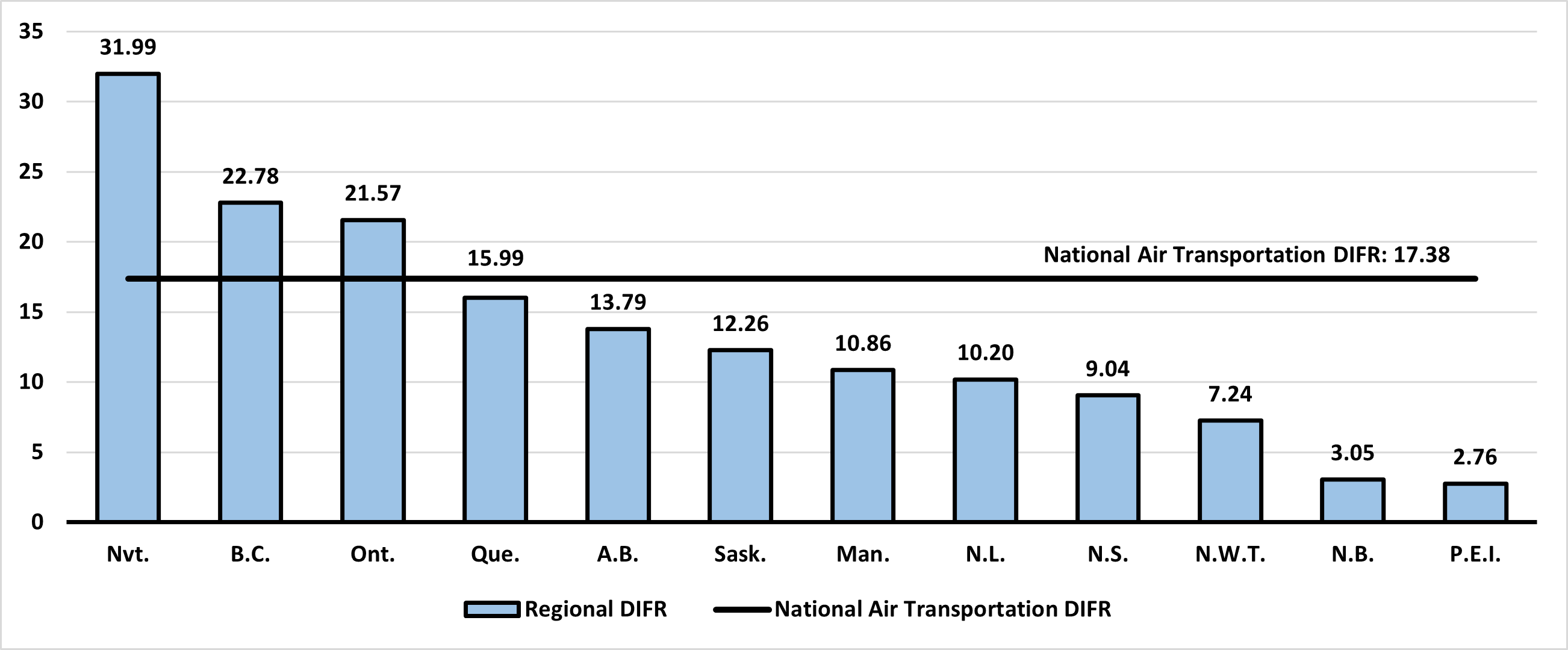
Chart 4.2 (c) – Text description
| Region | Disabling Injury Frequency Rate (DIFR) |
|---|---|
| Nvt. | 31.99 |
| B.C. | 22.78 |
| Ont. | 21.57 |
| Que. | 15.99 |
| A.B. | 13.79 |
| Sask. | 12.26 |
| Man. | 10.86 |
| N.L. | 10.20 |
| N.S. | 9.04 |
| N.W.T. | 7.24 |
| N.B. | 3.05 |
| P.E.I. | 2.76 |
| National Air Transportation DIFR | 17.38 |
As depicted in Chart 4.2 (c), Air Transportation employers across provinces and territories displayed significant variations in their safety performance measured by DIFR, ranging from the lowest rate of 2.76 (P.E.I.) to the highest rate of 31.99 (Nunavut). Note that the rate reported in Nunavut is nearly 2 times higher than the sectoral benchmark and more than 11 times higher than the lowest regional DIFR value.
Longshoring, Stevedoring, Port, Harbour Operations and Pilotage
The Longshoring sector reported a DIFR of 11.74 at the national level in 2021, which increased to 14.93 in 2022. Three provinces reported a DIFR above the 2022 sectoral benchmark.
| Region | DIFR | Disabling injuries | Hours worked |
|---|---|---|---|
| Ontario | 39.98 | 19 | 475,207 |
| British Columbia | 34.53 | 303 | 8,803,485 |
| New Brunswick | 33.12 | 13 | 392,508 |
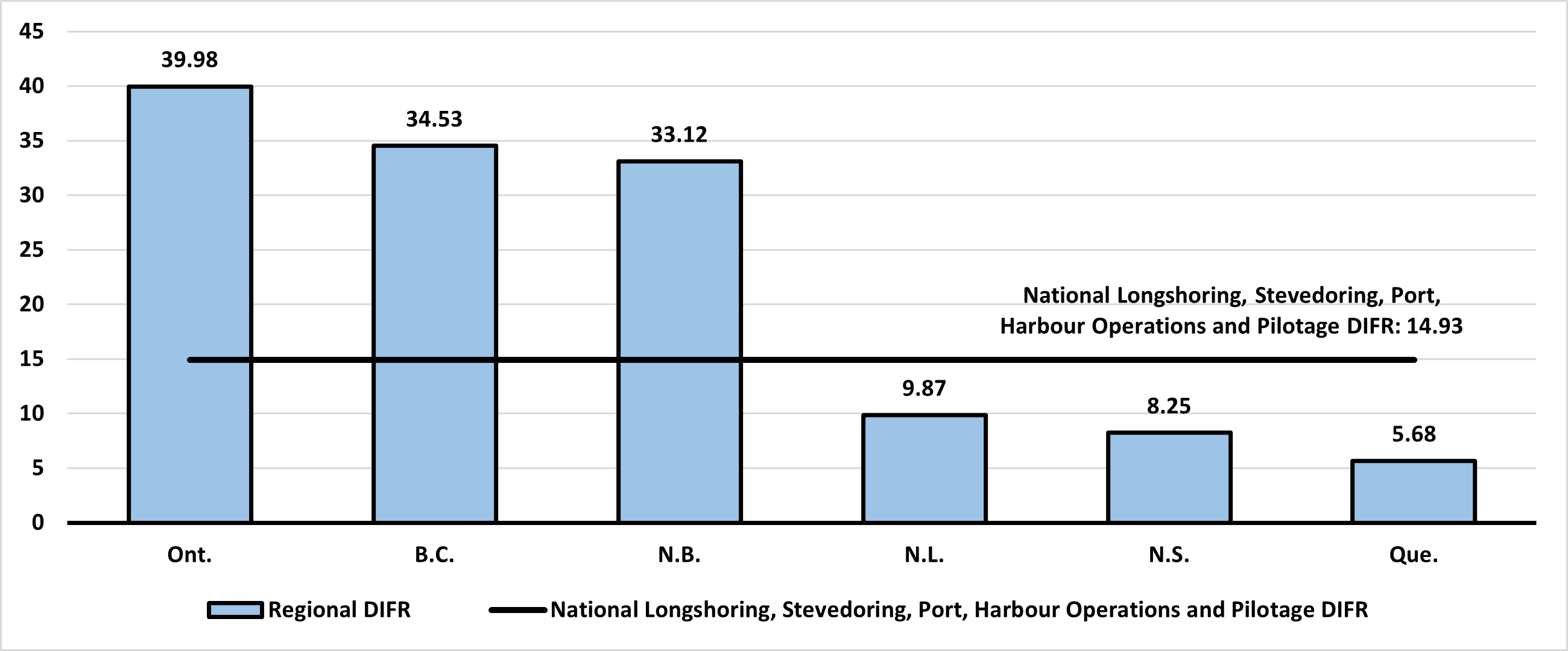
Chart 4.2 (d) – Text description
| Region | Disabling Injury Frequency Rate (DIFR) |
|---|---|
| Ont. | 39.98 |
| B.C. | 34.53 |
| N.B. | 33.12 |
| N.L. | 9.87 |
| N.S. | 8.25 |
| Que. | 5.68 |
| National Longshoring, Stevedoring, Port, Harbour Operations and Pilotage DIFR | 14.93 |
As illustrated in Chart 4.2 (d), Longshoring sector employers located in different provinces and territories vary considerably in their safety performance measured by DIFR, ranging from the lowest rate of 5.68 (Quebec) to the highest rate of 39.98 (Ontario).
Feed, Flour and Seed
The Feed, Flour and Seed sector reported a DIFR of 9.30 at the national level in 2021, which increased to 9.39 in 2022. Four provinces reported a DIFR above the 2022 rate.
| Region | DIFR | Disabling injuries | Hours worked |
|---|---|---|---|
| Newfoundland and Labrador | 49.80 | 2 | 40,159 |
| British Columbia | 33.06 | 35 | 1,058,588 |
| Manitoba | 9.96 | 23 | 2,309,376 |
| Saskatchewan | 9.42 | 26 | 2,758,870 |
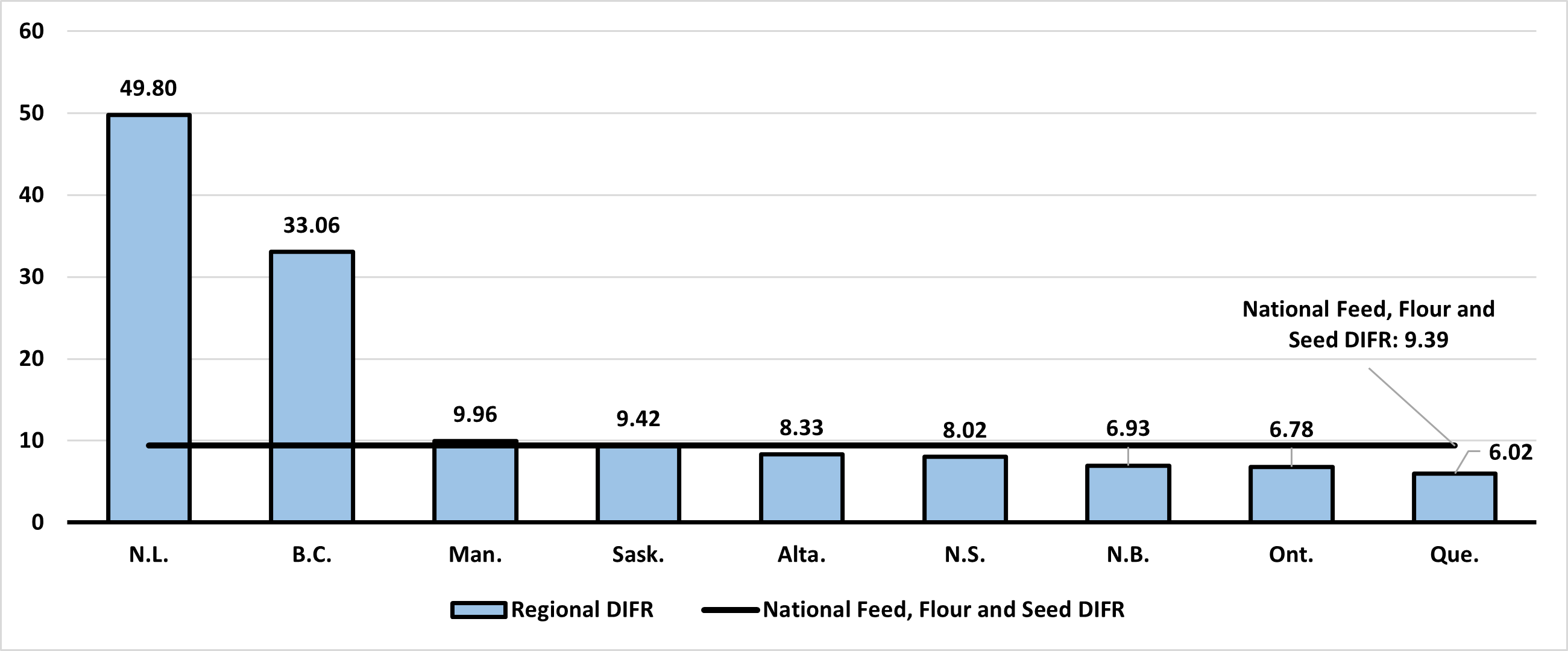
Chart 4.2 (e) – Text description
| Region | Disabling Injury Frequency Rate (DIFR) |
|---|---|
| N.L. | 49.80 |
| B.C. | 33.06 |
| Man. | 9.96 |
| Sask. | 9.42 |
| Alta. | 8.33 |
| N.S. | 8.02 |
| N.B. | 6.93 |
| Ont. | 6.78 |
| Que. | 6.02 |
| National Feed, Flour and Seed DIFR | 9.39 |
The DIFR values for employers within the Feed, Flour, and Seed sector suggest significant variations in workplace safety performance across provinces and territories. These rates range from the lowest rate of 6.02 (Quebec) to the highest rate of 49.80 (Nunavut), which is 5 times higher than the sector’s DIFR at the national level (9.93).
In summary, the substantial variations in DIFR observed within the sectors across various provinces and territories in this section highlight the importance of accounting for regional variations when evaluating workplace safety performance. It is imperative for all stakeholders, including governmental bodies and business entities, to collaborate in identifying the unique factors that contribute to elevated DIFR values in specific regions and to implement targeted safety initiatives accordingly.
Conversely, employers from provinces or territories exhibiting lower DIFR values are encouraged to share best practices that have been instrumental in fostering a safer working environment, particularly in the Road Transportation sector.
This analysis strongly advocates for the adoption of region-specific safety interventions, aimed at enhancing workplace safety standards within different sectors, and fostering inter-regional collaboration to develop and implement effective safety practices.
Section 5: Moving forward
The 2022 report highlights the complexity of occupational health and safety across various sectors and regions within Canada’s federal jurisdiction. While the increase in work-related disabling and fatal injuries is concerning, it may be influenced by the economic rebound and increased work activities following the COVID-19 global pandemic. The report showcases significant disparities in safety performance across different sectors and geographical areas, underscoring the importance of sector-specific and regionally-tailored safety interventions.
Overall, the 2022 annual report by the Labour Program of ESDC reveals a varied landscape of workplace safety performance following the COVID-19 global pandemic. It emphasizes the need for vigilant, informed, and collaborative efforts to enhance safety standards across all federally regulated sectors in Canada. Such efforts could include:
- Continued Monitoring: Sectors that show worsening safety performance or incomplete economic recovery warrant continuous monitoring and targeted interventions.
- Sharing of Best Practices: Regions and sectors with superior safety records should share their successful strategies and best practices to foster overall improvement in workplace safety.
- Data Utilization: Employers and policymakers should utilize the data provided to understand and address the specific safety challenges pertinent to their sectors and regions.
Annex: List of terms
The following definitions are used in this publication.
- Disabling injury
-
“Disabling injury” means an employment injury or an occupational disease that:
- prevents an employee from reporting for work or from effectively performing all the duties connected with the employee’s regular work on any day subsequent to the day on which the injury or disease occurred, whether or not that subsequent day is a working day for that employee
- results in the loss by an employee of a body member or part thereof or in the complete loss of the usefulness of a body member or part thereof, or
- results in the permanent impairment of a body function of an employee
- Disabling Injury Frequency Rate (DIFR)
- The total number of disabling and fatal occupational injuries per 1 million hours worked. The calculation is: (Total Disabling Injuries + Total Fatal Injuries)*1,000,000/Total Hours Worked.
- Employee
- Any person employed by an employer.
- Employer
- Any person who employs 1 or more employees and includes an employers’ organization and any person who acts on behalf of an employer.
- Employment
-
“Employment” is defined as:
- all work or activities performed in carrying out assignments or requests made by the employer. It includes related activities not specifically covered by an assignment or request
- any voluntary work or activities undertaken while on duty for the benefit of the employer, or
- any activities undertaken while on duty with the consent or approval of the employer
- Fatal Injury
- An occupational injury or disease resulting in death.
- Fatal Injury Frequency Rate (FIFR)
- The total number of fatal occupational injuries per 1 billion hours worked. The calculation is: Total Fatal Injuries*1,000,000,000/Total Hours Worked.
- Federal Jurisdiction
-
Federal jurisdiction covers:
- any work, undertaking or business that is within the legislative authority of Parliament, and
- any work deemed to be for the common good of 2 or more provinces and outside the exclusive authority of provincial legislatures
- Full-time Equivalent (FTE)
-
Refers to the employment of 1 person full time. It may also refer to more than 1 person part time whose total working time is the equivalent of 1 person working full time. For example:
- 100 people employed full time equals 100 FTEs
- 10 people employed half time equals 5 FTEs
- all 110 people combined represent 105 FTEs
- Minor Injury
-
“Minor injury” means an employment injury or an occupational disease for which medical treatment is provided and excludes a disabling injury.
Note: Medical treatment means medical care provided at a medical treatment facility, such as a hospital, medical clinic or doctor's office where a patient in need of emergency care can be treated. Not to be confused with first aid.
- Occupational Injury
- Any injury, disease or illness incurred by an employee in the performance of, or in connection with, his or her work.
Page details
- Date modified:
